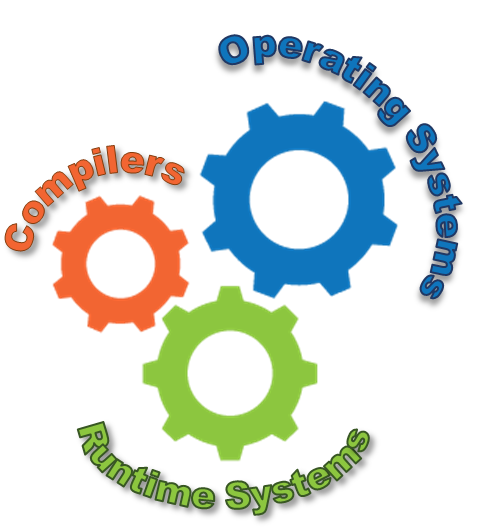
Compilers, Operating, and Runtime Systems for
Modern and Emerging Architectures
| Home | |||||
Leveraging Application Guidance for More Effective Management of Complex Memories
The Simplified Interface to Complex MemoryComputer systems with multiple tiers of memory with different performance and capabilities are quickly becoming mainstream. Conventional data management strategies will need to be altered to take advantage of different types of memory in each tier, but doing so faces significant challenges that are in urgent need of research. This collection of projects is developing new tools and infrastructure to extend the benefits of application guided data management to a variety of applications on new and emerging memory architectures, with little or no additional effort from developers and users.
Our primary research thrusts include:This work is supported by multiple grants from Intel Corporation and the National Science Foundation, including an NSF CAREER award. Example publications include: TACO 2024 (to appear), ISMM 2023, MemSys 2019 (a), NAS 2018 (Best Paper Award), and TACO 2018.
- developing new profiling and machine learning tools to extract memory management guidance from application source code and runtime behavior
- building new approaches that use both static and dynamic guidance to steer data management across complex memory hierarchies
- creating new optimizations that leverage tighter integration of application- and system-level activities to improve the efficiency of fundamental memory management operations, including data allocation, migration, and recycling
Secure Native Binary ExecutionThe U.S. Department of Energy (DOE) is working towards achieving new levels of scientific discovery through ever-increasingly powerful supercomputers. To make these computing environments viable, the DOE initiated a large effort titled the Exascale Computing Project (ECP). The Simplified Interface to Complex Memory (SICM), one of the ECP projects, seeks to deliver a simple and unified interface to the emerging complex memory hierarchies on exascale nodes. To achieve this goal, SICM is split into two separate interfaces: the low-level and the high-level. The high-level interface delivers an API that allows applications to allocate, migrate, and persist their data without detailed knowledge of the underlying memory hardware. To implement these operations efficiently, the high-level API invokes the low-level interface, which interacts directly with device-specific services in the operating system.
SICM is available for download in public repositories (see Software). Example publications include: IJHPCA 2024, TACO 2022, and MemSys 2019 (b).
Dynamic CompilationTypically, securing software is the responsibility of the software developer. The customer or end-user of the software does not control or direct the steps taken by the developer to employ best practice coding styles or mechanisms to ensure software security and robustness. Current systems and tools also do not provide the end-user with an ability to determine the level of security in the software they use. At the same time, any flaw or security vulnerabilities ultimately affect the end-user of the software. This project aimed to provide greater control to the end-user to actively assess and secure the software they use. Publications include: ISPEC 2021.
Exploiting Phase Interactions during Phase Order SearchPrograms written in managed languages, such as Java and C#, execute in the context of a virtual machine (VM) (also called runtime system) that compiles program methods at runtime to achieve high-performance emulation. Managed runtime systems need to consider several factors when deciding how, when, or if to compile program methods, including: the compiling speed and code quality produced by the available compiler(s), the execution frequency of individual methods, and the availability of compilation resources. Our research in this area explores tradeoffs involved in selective compilation and the potential of applying iterative search techniques to dynamic compilers.
Project efforts include:This work was supported by NSF (CCF-1617954). Example publications include: LCTES 2017, TACO 2016, LCTES 2016, TACO 2013, VEE 2013
- How to schedule method compiles for JITs with multiple optimization tiers
- Dynamic compilation policies for multi- and many-core machines.
- Program profiling for feedback-directed optimization
Program-specific or function-specific compiler optimization phase sequences are universally accepted to achieve better overall performance than any fixed optimization phase ordering. In order to find the best combination of phases to apply to a particular function or program, researchers have developed iterative search techniques to quickly evaluate many different orderings of optimization phases. While such techniques have been shown to be effective, they are also extremely time consuming due to the large number of phase combinations that must be evaluated for each application. We conduct research that aims to reduce the phase ordering search space by identifying and exploiting certain interactions between phases during the search. In addition to speeding up exhaustive iterative searches, this work has led to the invention of a technique that can improve the efficacy of individual optimization phases, as well as novel heuristics that find more effective phase ordering sequences much faster than current approaches.
This work was mostly done at the University of Kansas as a joint effort between (then PhD student) Michael Jantz and his advisor, Prof. Prasad Kulkarni. Example publications include: CASES 2013 S:P&E 2013, CASES 2010, Masters Thesis (2010), LCTES 2010